Choosing the right duvet is essential for staying warm and cosy during chilly Winter nights. As the temperature drops, having the appropriate bedding to provide insulation becomes important to achieving a restful sleep. Why not wrap up and have a read through our guide to choosing a duvet for Winter? After all, staying warm is key during the later months of the year…
Understanding duvets
Duvets are thick, padded blankets filled with insulating materials such as down, feathers, or synthetic fibres – they are paired with a removable cover, which is how they differ from comforters or blankets, which tend to be a bit thinner, too. A duvet is designed to provide warmth when you’re in bed, typically in standard mattress sizes. Duvets trap and retain body heat, creating a cosy layer that helps regulate your body temperature during cold nights.

Factors to consider when choosing a duvet for cold nights
There are several factors to consider when choosing cosy bedding for low temperatures. These include the fill material and power as well as the tog rating and the size of the duvet itself. Let’s look at each of those in a bit more detail…
Fill material
Plenty of different fill materials are on the market, with some of the most popular being down and a down alternative. Down is the layer found underneath a bird’s features, and it’s naturally insulating, lightweight and cosy. Some down duvets are hypoallergenic, but it depends on the quality. Feathers are sometimes used in duvets, and they can be super thick but also quite itchy. There are wool duvets, which are very insulating, and bamboo duvets, which are thermoregulating, eco-friendly, and super soft. Bamboo is one of the best duvet fill types for cold nights because it intuitively adapts to your temperature to keep you feeling right as you drift off.
Fill power
The fill power refers to how much of the fill material is inside the duvet – and the more of it there is, the warmer your duvet should be. When you’re looking at cold-weather bedding options, opt for a higher fill power where possible.
TOG rating
When we talk about TOG rating, this refers to how well a duvet retains heat during the night – essentially, how toasty you’ll be while you’re sleeping! Duvets are tested, and the higher the TOG rating, the more heat it can retain. So, if you’re a cold sleeper, look at Winter duvet recommendations with a high TOG – this tends to be how you can find the best duvet for cold weather.

Duvet size
As mentioned, duvet sizes typically correspond to mattress sizes: single, double, king and so on. Always be sure to check your mattress size when buying an insulated duvet for cold evenings because if your duvet is too small, you won’t feel cosy enough. It needs to be the right size for you and your bed!
Popular duvet options for winter nights
There are three really popular options for top-rated duvets for freezing nights: down, wool, and bamboo. Let’s snuggle in and have a look at each one in depth…
Down duvets
One really traditional duvet type is a down duvet; they are quite luxurious and super thick without being too heavy. They’re bound to keep you warm and cosy on cold Winter nights, but they can often be expensive and not always great for those with allergies.
Wool duvets
Wool is very insulating due to the crimped fibres – they create millions of tiny air pockets inside, working to trap the air itself and, therefore, slow the heat dissipation and transfer. This will keep you nice and toasty at night; wool is also hypoallergenic and moisture-wicking, making it a great option for a Winter duvet.
Bamboo duvets
A bamboo duvet is one of the best you can get in terms of cold-weather sleep solutions. Not only is it soft and warm, but bamboo is also thermoregulating and temperature intuitive: it reacts to how hot or cold you feel in order to adjust, having you feeling just right for supreme levels of comfort. This is because the fibres gently expand and retract based on the temperature, so you’ll always feel snug as you snooze. And not only that, but bamboo itself is naturally antibacterial, hypoallergenic, and eco-friendly!

Maintenance tips for cold-weather duvets
Maintaining your duvet is key to years of cosy Winters. Follow the manufacturer’s instructions, and look into how best to care for the type of duvet you have; can it be machine washed, as most duvets can, and tumble dried? Down duvets definitely should go in the tumble drier, for example, but bamboo duvets should not. If you want to freshen up your duvet without a proper wash, shake it and hang it on the line (on a dry day!) to air it out a little bit.
Add a duvet cover to your duvet; this allows you to adapt it to the room’s decor and protects your duvet against spillages, germs and dust. This keeps it looking and feeling fresh for longer! When it comes to storing your Winter duvet during the warmer months, be sure to do so somewhere dry and airy to avoid mould and mildew from attacking your snuggly duvet.
Conclusion
The warmest duvet for chilly nights is one that feels cosy and soft on the skin, and has enough fill power and a high enough TOG rating to keep you from feeling the chill in the air as you try to fall asleep. A thick and insulating duvet is key to getting a good night’s sleep during the colder months, which is ideal as this time of year can make us feel a bit down in the dumps. Make an informed decision by researching the top-rated duvets for freezing nights and choosing a material that suits you; we love bamboo, for its hypoallergenic nature and its thermoregulating properties.

![[MattressTopper] Panda London Memory Foam Bamboo Mattress Topper package box](http://pandalondon.com/cdn/shop/files/Bamboo_Mattress_Topper_Package_Box.webp?v=1742301823&width=1500)
![[MattressTopper] Panda London Memory Foam Bamboo Mattress Topper on the floor](http://pandalondon.com/cdn/shop/products/Panda-Memory-Foam-Bamboo-Mattress-Topper-Yoga-e1624045454555.jpg?v=1758795458&width=1000)
![[MattressTopper] Bamboo Mattress Topper Lifestyle Image with Memory Foam Pillows Product Page](http://pandalondon.com/cdn/shop/files/Bamboo_Mattress_Topper_Lifestyle_Image_with_Memory_Foam_Pillows_Product_Page.webp?v=1758795458&width=800)
![[MattressTopper] Bamboo Mattress Topper Lifestyle Image with Bamboo Pillows In the Garden room Product Page](http://pandalondon.com/cdn/shop/files/Bamboo_Mattress_Topper_Lifestyle_Image_with_Bamboo_Pillows_In_the_Garden_room_Product_Page.webp?v=1758795458&width=800)
![[MattressTopper] Panda London Memory Foam Bamboo Mattress Topper side](http://pandalondon.com/cdn/shop/files/Mattress_Topper_Isolated_-_resized.jpg?v=1758795458&width=800)
![[HybridMattressPro] Hybrid_Bamboo_Mattress_Pro_Product_Image_2026](http://pandalondon.com/cdn/shop/files/Hybrid_Bamboo_Mattress_Pro_Product_Image_2026.webp?v=1764944771&width=1000)
![[HybridMattressPro] Breathable Hybrid Bamboo Mattress](http://pandalondon.com/cdn/shop/products/Breathable-Hybrid-Bamboo-Mattress.jpg?v=1764944771&width=1920)
![[HybridMattressPro] Hybrid Bamboo Mattress Pro Cover Zip](http://pandalondon.com/cdn/shop/files/Hybrid_Bamboo_Mattress_Cover.jpg?v=1764944771&width=800)
![[HybridMattressPro] Panda Hybrid Bamboo Mattress Pro](http://pandalondon.com/cdn/shop/files/Hybrid_Bambo_Memory_Foam_Mattress_-_BioCell_Foam_x.jpg?v=1764944771&width=800)
![[HybridMattressPro] Couple on a Hybrid Bamboo Mattress Pro](http://pandalondon.com/cdn/shop/files/Hybrid_Bamboo_Mattress_Couple.jpg?v=1764944771&width=800)
![[CloudDuvet] Panda London The Cloud Bamboo Duvet Packaging](http://pandalondon.com/cdn/shop/products/Panda-London-The-Cloud-Bamboo-Duvet-Panda-Life-scaled_00a651ad-4ca3-4105-b520-12a94c1a4f71.jpg?v=1713363286&width=1920)
![[CloudDuvet] Panda London The Cloud Bamboo Duvet Rolled](http://pandalondon.com/cdn/shop/products/Duvet-Listing-Images03.jpg?v=1764079307&width=1000)
![[CloudDuvet] Panda London The Cloud Bamboo Duvet Girl Huggin a Duvet on the Bed](http://pandalondon.com/cdn/shop/files/Cloud_Bamboo_Duvet_-_Lady_Hugging_it_on_Bed_LifestyleImage.jpg?v=1764079307&width=1000)
![[CloudDuvet] Panda London The Cloud Bamboo Duvet Guy In the Air with Cloud Bamboo Duvet](http://pandalondon.com/cdn/shop/files/GuyonaHybridBambooMattresswithCloudDuvet.jpg?v=1764079307&width=2000)
![[CloudDuvet] Panda Cloud Duvet Winter on the bed lifestyle image](http://pandalondon.com/cdn/shop/files/Panda_Cloud_Duvet_Winter_on_the_Bed_Lifestyle-1_image.jpg?v=1764079307&width=1000)
![[BBWhite] White 100% Bamboo Bedding](http://pandalondon.com/cdn/shop/files/Pure_White_Full_Bed.webp?v=1719581797&width=1000)
![[BBWhite] White 100% Bamboo Bedding Texture](http://pandalondon.com/cdn/shop/files/100_Bamboo_Bedding_-_Pure_White_-_Close_Up_02.webp?v=1762879591&width=1000)
![[BBWhite] White 100% Bamboo Bedding Woman in bed sleeping](http://pandalondon.com/cdn/shop/files/100-Bamboo-Bedding-Set-Pure-White-BB.webp?v=1762879591&width=768)
![[BBWhite] White 100% Bamboo Bedding Woman Duvet cover buttons](http://pandalondon.com/cdn/shop/files/hand_and_buttons_1.webp?v=1762879591&width=1000)
![[BBWhite] White 100% Bamboo Bedding Woman in bed looking and smiling-](http://pandalondon.com/cdn/shop/files/SatonMadeBed-White100_BambooBedding-white_-_BB_SideShot1000x1000.webp?v=1762879591&width=980)
![[BBUrbanGrey] Urban Grey 100% Bamboo Bedding](http://pandalondon.com/cdn/shop/files/Made_Bed_-_Urban_Grey_-_Wide_Shot_2_1_1.webp?v=1762880019&width=1000)
![[BBUrbanGrey] Cloud Duvet Urban Grey 100% Bamboo Bedding Set](http://pandalondon.com/cdn/shop/files/Cloud_Duvet_-_Grey_-_Close_up_2.webp?v=1762880019&width=1000)
![[BBUrbanGrey] Urban Grey 100% Bamboo Bedding Set Woman sitting on the bed](http://pandalondon.com/cdn/shop/files/Sat_in_Bed_-_Grey_100__Bamboo_Bedding_-_Wide_Shot.webp?v=1762880019&width=1000)
![[BBUrbanGrey] Urban Grey 100% Bamboo Bedding Set Woman Duvet buttons Panda London](http://pandalondon.com/cdn/shop/files/hand_buttons_grey_bedding_1.webp?v=1762880019&width=1000)
![[BBUrbanGrey] Woman Sitting on the Bamboo Bedding with coffee](http://pandalondon.com/cdn/shop/files/SatonMadeBed-White100_BambooBedding-SideShot1000x1000.jpg?v=1762880019&width=1000)
![[BBNavyBlue] Deep Sea Navy Blue 100% Bamboo Bedding](http://pandalondon.com/cdn/shop/files/Made_Bed_-_Navy_-_Wide_Shot_3_copy.webp?v=1762879591&width=1000)
![[BBNavyBlue] Deep Sea Navy Blue 100% Bamboo Bedding Texture](http://pandalondon.com/cdn/shop/files/Cloud_Duvet_-_Navy_-_Close_up_2.webp?v=1762880019&width=1000)
![[BBNavyBlue] Deep Sea Navy Blue 100% Bamboo Bedding Woman Sitting on the bed](http://pandalondon.com/cdn/shop/files/Sat_Up_in_Bed_-_Navy_100__Bamboo_Bedding_-_Hands_on_Bed.webp?v=1762880019&width=1000)
![[BBNavyBlue] Deep Sea Navy Blue 100% Bamboo Bedding Duvet Cover Buttons](http://pandalondon.com/cdn/shop/files/Cloud_Duvet_Cover_Buttons_-_Deep_Sea_Navy.webp?v=1762880019&width=1000)
![[BBNavyBlue] Deep Sea Navy Blue 100% Bamboo Bedding Woman sitting on the bed looking away](http://pandalondon.com/cdn/shop/files/SatonMadeBed-White100_BambooBedding-SideShot1000x1000-001.webp?v=1762880019&width=980)
![[BBPink] Vintage Pink Blue 100% Bamboo Bedding](http://pandalondon.com/cdn/shop/files/Made_Bed_-_Pink_-_Wide_Shot_copy.webp?v=1762879591&width=1000)
![[BBPink] Vintage Pink Texture 100% Bamboo Bedding](http://pandalondon.com/cdn/shop/files/Cloud_Duvet_-_Pink_-_Close_up_2.webp?v=1762880019&width=1000)
![[BBPink] Vintage Pink Woman Sitting on the 100% Bamboo Bedding](http://pandalondon.com/cdn/shop/files/Sat_Up_in_Bed_-_Pink_-_Hands_on_Bed.webp?v=1762880019&width=1000)
![[BBPink] Vintage Pink Woman Sitting on the 100% Bamboo Bedding Duvet Cover](http://pandalondon.com/cdn/shop/files/Cloud_Duvet_Cover_Buttons_-_Vintage_Pink.webp?v=1762880019&width=1000)
![[BBPink] Vintage Pink Woman Sitting on the 100% Bamboo Bedding Woman looking far away](http://pandalondon.com/cdn/shop/files/SatonMadeBed-White100_BambooBedding-SideShot1000x1000-001_Vintage_Pink.webp?v=1762880019&width=980)
![[BBGrey] Light Grey 100% Bamboo Bedding](http://pandalondon.com/cdn/shop/files/Made_Bedding_in_Bedroom_-_Urban_Grey_-_Wide_Shot.webp?v=1762879591&width=1000)
![[BBGrey] Light Grey 100% Bamboo Bedding texture](http://pandalondon.com/cdn/shop/files/Texture17.webp?v=1762880019&width=1000)
![[BBGrey] Light Grey 100% Bamboo Bedding with Woman smiling](http://pandalondon.com/cdn/shop/files/Sat_Up_in_Bed_-_Grey_-_Hands_on_Bed.webp?v=1762880019&width=1000)
![[BBGrey] Light Grey 100% Bamboo Bedding with Duvet Cover buttons](http://pandalondon.com/cdn/shop/files/Cloud_Duvet_Cover_Buttons_-_Quiet_Grey.webp?v=1762880019&width=1000)
![[BBGrey] Light Grey 100% Bamboo Bedding with Woman smiling and sitting coffee](http://pandalondon.com/cdn/shop/files/SatonMadeBed-White100_BambooBedding-SideShot1000x1000-002-_Grey.webp?v=1762880019&width=980)
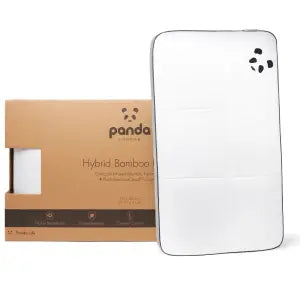 Hybrid Bamboo Pillow
Hybrid Bamboo Pillow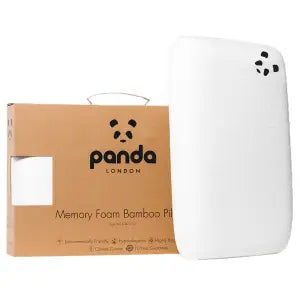 Memory Foam Bamboo Pillow
Memory Foam Bamboo Pillow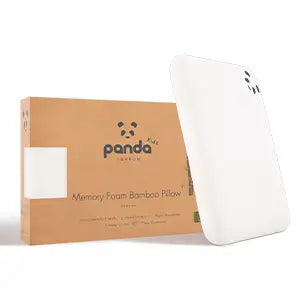 Kids Memory Foam Bamboo Pillow
Kids Memory Foam Bamboo Pillow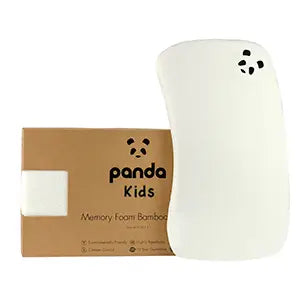 Baby Memory Foam Bamboo Pillow
Baby Memory Foam Bamboo Pillow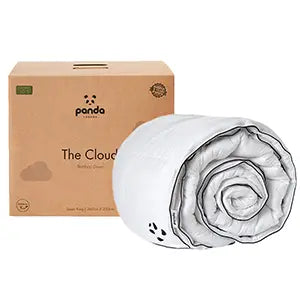 Panda Cloud Duvet
Panda Cloud Duvet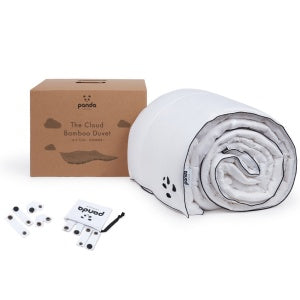 Bamboo Summer Duvet
Bamboo Summer Duvet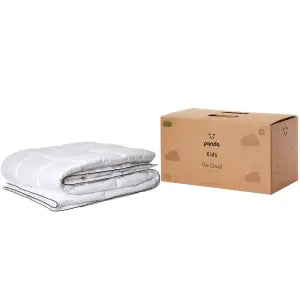 Kids Cloud Duvet
Kids Cloud Duvet
![[KidsDuvet] Kids Cloud Duvet product image](http://pandalondon.com/cdn/shop/products/Panda-London_Kids_Duvet-scaled.jpg?v=1713363289&width=1920)
![[KidsDuvet] Kids Cloud Duvet on a cotbed](http://pandalondon.com/cdn/shop/files/Kids-KidsCloudDuvet.jpg?v=1750342405&width=2000)
![[KidsDuvet] Kids Cloud Bamboo Duvet Folded](http://pandalondon.com/cdn/shop/files/Kids_Cloud_Bamboo_Duvet_-_Folded_-_Logo_Shown_-_White_Background_Kids_Duvet.jpg?v=1750342405&width=1000)
![[KidsDuvet] Kids_CloudBambooDuvet-CornerLip-WhiteBackground](http://pandalondon.com/cdn/shop/files/Kids_CloudBambooDuvet-CornerLip-WhiteBackground.jpg?v=1750342405&width=2000)
![[KidsDuvet] Kids_Cloud_Bamboo_Duvet_-_Padded_-_Close_Up_Shot_Kids](http://pandalondon.com/cdn/shop/files/Kids_Cloud_Bamboo_Duvet_-_Padded_-_Close_Up_Shot_Kids.jpg?v=1750342405&width=1000)
![[KidsDuvet] Kids_CloudBambooDuvetRolled-WhiteBackground_1](http://pandalondon.com/cdn/shop/files/Kids_CloudBambooDuvetRolled-WhiteBackground_1.jpg?crop=region&crop_height=1697&crop_left=151&crop_top=0&crop_width=1697&v=1750342405&width=2000)
![[KidsDuvetUKSingle] UK_Single_kids_-_Summer_Cloud_Duvet_Main_Image](http://pandalondon.com/cdn/shop/files/UK_Single_kids_-_Summer_Cloud_Duvet_Main_Image.webp?v=1750342648&width=1000)
![[KidsDuvetUKSingle] UK_Single_Kids-Image_Summer_Bamboo_Duvet_Lifestyle_image-1](http://pandalondon.com/cdn/shop/files/UK_Single_Kids-Image_Summer_Bamboo_Duvet_Lifestyle_image-1.webp?v=1750342794&width=1000)
![[KidsDuvetUKSingle]UK_Single_Summer_Duvet_-_Duvet_Folded_Isolated-webp](http://pandalondon.com/cdn/shop/files/UK_Single_Summer_Duvet_-_Duvet_Folded_Isolated-webp.webp?v=1750342794&width=1000)
![[KidsDuvetUKSingle] UK_Single_Summer_Duvet_-_Snuggle_Snaps_Bag_02-webp](http://pandalondon.com/cdn/shop/files/UK_Single_Summer_Duvet_-_Snuggle_Snaps_Bag_02-webp.webp?v=1750343051&width=1000)
![[KidsDuvetUKSingle] UK_Single_Kids_-_Summer_Cloud_Snuggle_Snaps_Image_Webp](http://pandalondon.com/cdn/shop/files/UK_Single_Kids_-_Summer_Cloud_Snuggle_Snaps_Image_Webp.webp?v=1764079307&width=1500)
![[KidsDuvetAllSeason] Kids Duvet UK Single 10.5 tog rating all season one](http://pandalondon.com/cdn/shop/files/Kids_All_Seasn_10.5_Tog_Panda_Cloud_Duvet_Main_Image.jpg?v=1750685858&width=1920)
![[KidsDuvetAllSeason] Texture Duvet Cloud Panda](http://pandalondon.com/cdn/shop/files/Kids_All_Season_Panda_Cloud_Bamboo_Duvet_-_Padded_-_Close_Up_Shot.jpg?crop=region&crop_height=1900&crop_left=169&crop_top=0&crop_width=1900&v=1750686755&width=2239)
![[KidsDuvetAllSeason] Rolled Duvet All Season 10.5 tog](http://pandalondon.com/cdn/shop/files/Kids_All_Season_Duvet_Image_002_Panda_Cloud_Duvet.jpg?v=1750686755&width=1000)
![[KidsDuvetAllSeason] Panda Cloud Duvet Corner](http://pandalondon.com/cdn/shop/files/Kids_All_Season_Panda_Cloud_Cloud_Bamboo_Duvet_-_Corner_Lip_-_White_Background.jpg?v=1750686755&width=4848)
![[KidsDuvetAllSeason] All season Panda Cloud Duvet](http://pandalondon.com/cdn/shop/files/Kids_All_Season_Duvet_UK_Single_Kids-Image_Summer_Bamboo_Duvet_Lifestyle_image-1_webp.jpg?v=1750686755&width=1000)
![[PureWhiteDC] White Duvet Cover 100% Bamboo Bedding buttons](http://pandalondon.com/cdn/shop/files/ButtonsDuvetCoverPureWhite.jpg?v=1714123697&width=2000)
![[PureWhiteDC] White Duvet Cover 100% Bamboo Bedding Package](http://pandalondon.com/cdn/shop/files/White_Duvet_Cover_Bamboo_Bedding_Package.webp?v=1721052312&width=1811)
![[PureWhiteDC] White Duvet Cover 100% Bamboo Bedding Stripes](http://pandalondon.com/cdn/shop/files/White_Duvet_Cover_Straps_100_Bamboo_Bedding.webp?v=1721052311&width=1000)
![[PureWhiteDC] White Duvet Cover 100% Bamboo Bedding Texture](http://pandalondon.com/cdn/shop/files/White_Duvet_Cover_100_Bamboo_Bedding_-_Pure_White_-_Duvet_Cover_Texture.webp?v=1721052312&width=1000)
![[PureWhiteDC] White Duvet Cover 100% Bamboo Bedding Woman buttons hands](http://pandalondon.com/cdn/shop/files/White_Duvet_Cover_-_Woman_hands_and_buttons.webp?v=1721052312&width=1000)
![[VintagePinkDC] Vintage Pink Duvet Cover 100% Bamboo Bedding buttons](http://pandalondon.com/cdn/shop/files/Vintage_Pink_Duvet_Cover_Bamboo_Bedding_Buttons.webp?v=1743769041&width=1000)
![[VintagePinkDC] Vintage Pink Duvet Cover 100% Bamboo Bedding package](http://pandalondon.com/cdn/shop/files/Vintage_Pink_Duvet_Cover_Package_Bamboo_Bedding.webp?v=1743769041&width=1811)
![[VintagePinkDC] Vintage Pink Duvet Cover 100% Bamboo Bedding Stripes](http://pandalondon.com/cdn/shop/files/Vintage_Pink_Duvet_Cover_Bamboo_Bedding_Stripes.jpg?v=1721052469&width=1000)
![[VintagePinkDC] Vintage Pink Duvet Cover 100% Bamboo Bedding Texture](http://pandalondon.com/cdn/shop/files/Vintage_Pink_Duvet_Cover_Bamboo_Bedding_Texture.webp?v=1743769041&width=1000)
![[VintagePinkDC] Vintage Pink Duvet Cover 100% Bamboo Bedding Woman In Bed Sitting](http://pandalondon.com/cdn/shop/files/Vintage_Pink_Duvet_Cover_Bamboo_Bedding_Woman_in_bed.webp?v=1721052470&width=1000)
![[NavyDC] Deep Sea Navy Duvet Cover 100% Bamboo Bedding Buttons](http://pandalondon.com/cdn/shop/files/Deep_Sea_Navy_Buttons_Duvet_Cover_Bamboo_Bedding.webp?v=1744115105&width=1000)
![[NavyDC] Deep Sea Navy Duvet Cover 100% Bamboo Bedding Package](http://pandalondon.com/cdn/shop/files/Deep_Sea_Navy_Package_Duvet_Cover_Bamboo_Bedding.webp?v=1744115105&width=1811)
![[NavyDC] Deep Sea Navy Duvet Cover 100% Bamboo Bedding Stripes](http://pandalondon.com/cdn/shop/files/Deep_Sea_Navy_Stripes_Duvet_Cover_Bamboo_Bedding.webp?v=1721053122&width=1000)
![[NavyDC] Deep Sea Navy Duvet Cover 100% Bamboo Bedding Texture](http://pandalondon.com/cdn/shop/files/Deep_Sea_Navy_Texture_Duvet_Cover_Bamboo_Bedding.webp?v=1744115105&width=1000)
![[NavyDC] Deep Sea Navy Duvet Cover 100% Bamboo Bedding Woman in bed sitting](http://pandalondon.com/cdn/shop/files/Deep_Sea_Navy_Woman_in_bed_Duvet_Cover_Bamboo_Bedding.webp?v=1721053123&width=1000)
![[GreyDC] Quiet Grey Duvet Cover 100% Bamboo Bedding Buttons](http://pandalondon.com/cdn/shop/files/Quiet_Grey_Cloud_Duvet_Cover_Bamboo_Bedding_Buttons.webp?v=1721053361&width=1000)
![[GreyDC] Quiet Grey Duvet Cover 100% Bamboo Bedding Package](http://pandalondon.com/cdn/shop/files/Quiet_Grey_Package_Duvet_Cover_Bamboo_Bedding_Buttons.webp?v=1721053360&width=1811)
![[GreyDC] Quiet Grey Duvet Cover 100% Bamboo Bedding Stripes](http://pandalondon.com/cdn/shop/files/Quiet_Grey_Stripes_Duvet_Cover_Bamboo_Bedding_Buttons.webp?v=1721053360&width=1000)
![[GreyDC] Quiet Grey Duvet Cover 100% Bamboo Bedding Texture](http://pandalondon.com/cdn/shop/files/Quiet_Grey_Texture_Duvet_Cover_Bamboo_Bedding_Buttons.webp?v=1721053361&width=1000)
![[GreyDC] Quiet Grey Duvet Cover 100% Bamboo Bedding Woman sitting in bed smiling](http://pandalondon.com/cdn/shop/files/Quiet_Grey_woman_in_bed_Duvet_Cover_Bamboo_Bedding_Buttons.webp?v=1721053361&width=1000)
![[UrbanGreyDC] Urban Grey Duvet Cover 100% Bamboo Bedding Buttons Woman hand](http://pandalondon.com/cdn/shop/files/Urban_Grey_Duvet_Grey_Bamboo_Bedding_buttons.webp?v=1721053513&width=1000)
![[UrbanGreyDC] Urban Grey Duvet Cover 100% Bamboo Bedding Buttons Package](http://pandalondon.com/cdn/shop/files/Duvet_Cover_Urban_Grey_Package_Bamboo_Bedding.webp?v=1721053512&width=1811)
![[UrbanGreyDC] Urban Grey Duvet Cover 100% Bamboo Bedding Stripes](http://pandalondon.com/cdn/shop/files/Urban_Grey_Duvet_Grey_Bamboo_Bedding_Stripes.webp?v=1721053512&width=1000)
![[UrbanGreyDC] Urban Grey Duvet Cover 100% Bamboo Bedding Buttons Texture](http://pandalondon.com/cdn/shop/files/Urban_Grey_Duvet_Grey_Bamboo_Bedding_Texture.webp?v=1721053513&width=1000)
![[UrbanGreyDC] Urban Grey Duvet Cover 100% Bamboo Bedding Buttons Woman sitting in bed smiling](http://pandalondon.com/cdn/shop/files/Urban_Grey_Duvet_Grey_Bamboo_Bedding_Woman_in_bed.webp?v=1721053513&width=1000)
![[ForestGreen] Signature Plus Bamboo Duvet Cover Package](http://pandalondon.com/cdn/shop/files/Bamboo-Lyocell-Duvet-Cover-Green-Package.jpg?v=1715253572&width=768)
![[ForestGreen] Signature Plus Bamboo Duvet Cover Lifestyle Image](http://pandalondon.com/cdn/shop/files/Green-Bedding-Green-Duvet.jpg?v=1715253572&width=768)
![[ForestGreen] Signature Plus Bamboo Texture](http://pandalondon.com/cdn/shop/files/Green-Texture_a3822675-18cd-4a67-9707-bda67458231f-DC.jpg?v=1725886574&width=768)
![[ForestGreen] Signature Plus Bamboo Corner Image](http://pandalondon.com/cdn/shop/files/Green-PC-Corner-DC.jpg?v=1725886574&width=768)
![[ForestGreen] Signature Plus Bamboo Button](http://pandalondon.com/cdn/shop/files/Bamboo-Lyocell-Buttons-Green-DC.jpg?v=1725886575&width=768)
![[ForestGreen] Signature Plus Bamboo Full Bedding Set Lifestyle Image](http://pandalondon.com/cdn/shop/files/Green-Bedding-Full-Set-DC.jpg?v=1725886574&width=768)
![[Pebble] Duvet Cover SignaturePlus Bamboo Package](http://pandalondon.com/cdn/shop/files/LyocellBambooBeddingButtons.jpg?v=1725886713&width=768)
![[Pebble] Duvet Cover SignaturePlus Bamboo Lifestyle](http://pandalondon.com/cdn/shop/files/Pebble-Cream-Bedding-Duvet.jpg?v=1725886713&width=768)
![[Pebble] Duvet Cover SignaturePlus Bamboo Texture](http://pandalondon.com/cdn/shop/files/Pebble-Cream-Texture-DC.jpg?v=1725886574&width=768)
![[Pebble] Duvet Cover SignaturePlus Bamboo Corner](http://pandalondon.com/cdn/shop/files/Pebble-Cream-PC-Corner-DC.jpg?v=1725886574&width=768)
![[Pebble] Duvet Cover SignaturePlus Bamboo Button](http://pandalondon.com/cdn/shop/files/Pebble-Cream-Button-DC.jpg?v=1725886575&width=768)
![[Pebble] Duvet Cover SignaturePlus Bamboo Lifestyle Full Bedding](http://pandalondon.com/cdn/shop/files/Pebble-Cream-Bedding-Full-Set-DC.jpg?v=1725886575&width=768)
